Local Vehicle Density Estimation on Highways Using Awareness Messages and Broadcast Reliability of Vehicular Communications
Abstract
1. Introduction
1.1. Research Background
| Term. | Description | Standard/Reference |
|---|---|---|
| ITS | Intelligent Transportation System: Integrated systems using advanced information and communication technologies for efficient, safe, and sustainable transportation management. | ISO/TC 204 [19]; ETSI TC ITS [20]; SAE [12] |
| V2X | Vehicle-to-Everything: A communication paradigm enabling vehicles to exchange data with other vehicles (V2V), infrastructure (V2I), pedestrians (V2P), and networks (V2N) to enhance safety and road traffic efficiency. | 3GPP Rel. 14 [21] |
| ICV | Intelligent connected vehicles: vehicles equipped with advanced sensors, communication technologies, and computing capabilities that enable real-time data exchange and autonomous or semi-autonomous driving to enhance safety, efficiency, and mobility. | [8,9] |
| AM | Awareness Message: Generic term for periodic broadcast messages that provide information about the vehicle or its environment, such as position, speed, and heading, to enhance situational awareness. | [22] |
| BSM | Basic Safety Message: A standardized message format broadcasting essential vehicle safety data to nearby entities, typically at 10 Hz. | SAE J2735 [12]. |
| CAM | Cooperative Awareness Message: A message type for periodic broadcast of vehicle state to support cooperative perception and collision avoidance. | ETSI EN 302 637-2 [13] |
| PRP | Packet Reception Probability: A theoretical probability that a single packet is successfully received, often modeled as a function of distance and channel conditions. | [23] |
| PRR | Packet Reception Ratio: A statistical variable representing the ratio of successfully received packets to the total transmitted packets, measured through experiments or simulations. | [24,25] |
| NAP | Node Awareness Probability: The probability that the host vehicle detects a specific neighbor vehicle by receiving at least one awareness message within a predefined observation period. | Proposed in this paper. |
| AAR | Average Awareness Ratio: The ratio of the number of sensed vehicles (detected via awareness messages) to the total number of vehicles within the communication range. | Proposed in this paper. |
1.2. Challenges and Innovations
1.3. Contributions
- (a)
- We introduce two application-layer reliability metrics: NAP, which denotes the probability of a host vehicle detecting a neighboring vehicle through received AMs, and AAR, which represents the ratio of sensed vehicles to the total number of vehicles within the communication range. These metrics form the foundation for effective vehicle density estimation.
- (b)
- We propose a vehicle density estimation method that operates locally on host vehicles using received AMs without additional infrastructure or communication overhead. For highway scenarios with homogeneous vehicle distributions, the method computes AAR by integrating NAP over the receiving distance, enhancing accuracy and supporting robust traffic management in V2V communication systems.
- (c)
- We analyze the impact of PRR refinement on the accuracy of vehicle density estimation under imperfect channel conditions. By aligning the measured PRR values with the PRP–distance curve, the proposed approach mitigates channel-induced distortion and enhances estimation robustness.
- (d)
- We validate the proposed density estimation method through simulations using the discrete-event network simulator NS2 (version 2.34) [27] under various vehicle density scenarios. The results demonstrate higher accuracy compared to methods relying solely on the number of sensed vehicles, with practical applications exemplified in congestion control studies.
1.4. Organizations
2. Related Work
3. Proposed Framework, System Model, and Assumptions
3.1. Proposed Framework for Vehicle Density Estimation
- Host vehicle is the vehicle that estimates vehicle density, and it is marked as .
- Remote vehicles are defined as the neighbors of the . The i-th remote vehicle is marked as .
- Sensed vehicle is defined as a remote vehicle from which the host vehicle receives at least one AM within the observation period. The i-th sensed vehicle is marked as .
3.2. System Model and Assumptions
- (a)
- Vehicles are distributed homogeneously on the highway, with a real vehicle density ;
- (b)
- All vehicles are equipped with the same on-board wireless transmission devices, which means the technology penetration rate is 100%;
- (c)
- All devices on the vehicles have the same configurations, including transmit power , data rate , and so on;
- (d)
- The received power with distance d away from the transmitter follows a fading/shadowing channel model, which can be expressed as follows [23]:where is the path loss. is a random gain variable representing the effects of fading and shadowing, characterized by the probability density function (PDF) of the power : .
- (e)
- A deterministic communication range is assumed, where [23], and is the receiving power threshold. According to the path loss law, we havewhere is the reference distance, is the path loss exponent, and is a dimensionless constant in the path loss law determined by the carrier frequency f and the reference distance for the antenna far field, and c is the speed of light.
4. Broadcast Reliability and Vehicle Density Estimation
4.1. Packet Reception Ratio (PRR) Estimation
4.1.1. Pairwise PRR
4.1.2. Observation Distances
4.1.3. PRR Estimation over Observation Distances
4.1.4. PRP–Distance Function Fitting
- (a)
- Among the m discrete PRR–distance points, the index of the inflection point is denoted by .
- (b)
- The index of a specific point is marked as if the NAPs derived from the subsequent points no longer meet the quality of service (QoS) requirement, which is a threshold (e.g., 99.9%).
- (c)
- Another PRR–distance point is marked as by Equation (9)where is the index of the last PRR–distance point.
- (d)
- The PRRs of the points with indices greater than are reconstructed using Equation (10):where s is the slope calculated from two PRR–distance points with indices and , and are the PRR and distance of the point .
| Algorithm 1 PRPFunctionFitting(). |
| Require: discrete PRR–distance points calculated within , predefined threshold and QoS requirement . |
| Ensure: is a monotonically decreasing function |
| 1: Smoothed PRR–distance points ← linear smoothing filter (PRR–distance points) |
| 2: Initialize . |
| 3: while do |
| 4: ← polynomial fitting (Smoothed PRR–distance) |
| 5: ← calculate PRP at the observation distance according to |
| 6: calculate the sum of squared residuals by Equation (8). |
| 7: end while |
| 8: if the inflection point exists in then |
| 9: the index of the inflection point |
| 10: the index of the last point that the NAP could meet the required threshold |
| 11: the index of the point following the Equation (9) |
| 12: Calculate the slope between the points indexed and . |
| 13: Reconstruct the whose index |
| 14: redo lines to refit the |
| 15: end if |
| 16: return |
4.2. Node Awareness Probability (NAP) Estimation
4.3. Average Awareness Ratio (AAR) Estimation
4.4. Density Estimation
5. Simulations
5.1. Simulation Settings
5.1.1. Traffic Scenario
5.1.2. Communication Settings
5.2. Simulation Process
5.3. Simulation Results
5.3.1. PRP/NAP Estimation in Different Densities
5.3.2. Inflection Point Analysis
5.3.3. The Estimated Vehicle Density
5.3.4. The Impact of Vehicle Speed on Estimation Accuracy
5.3.5. Apply the Estimated Density to Adjust AM Rate
6. Limitations and Future Developments
6.1. Limitations
- Uniform vehicle distribution assumption: The model assumes a uniform vehicle distribution (Section 3.2), which simplifies the derivation of NAP and AAR (Equations (11)–(13)) but limits its applicability to complex scenarios like intersections, where traffic patterns are non-uniform.
- Variable communication distance: The communication range (as shown in Equation (2)) varies across channel conditions, requiring specific estimation, as described in Section 3.2. This variability challenges the model’s performance in diverse environments.
- Idealized simulation environment: The validation relies on SUMO and NS2 simulations (Section 5.1) using idealized channel models (e.g., Nakagami fading), which do not account for real-world hardware constraints or environmental factors such as congestion or weather.
- High penetration rate requirement: The model assumes a high penetration rate of V2V communication devices (Section 1.1), which may not hold in scenarios with partial deployment, affecting scalability and performance.
6.2. Future Developments
- Extension to non-uniform scenarios: To adapt the model for intersections and urban environments, future work will incorporate non-uniform traffic patterns and multi-directional intersections in V2X broadcasts. This can be achieved by modifying NAP and AAR calculations to account for signal interference at crossings, using SUMO’s intersection modules for simulation-based validation.
- Real-world validation with hardware-in-the-loop (HIL) testing: To overcome the limitations of idealized simulations, we plan to conduct HIL experiments and field trials using real V2X devices (e.g., IEEE 802.11p or 5G NR-V2X). These experiments will measure PRR and NAP under non-ideal conditions, such as high-density congestion or adverse weather, to verify the model’s performance in real-world scenarios.
- Enhancement with advanced technologies: The newly introduced NAP and AAR metrics (Section 4) can be leveraged for theoretical studies in V2X reliability. Future work will explore integration with 5G NR-V2X or AI-enhanced estimation techniques to improve density estimation in high-density scenarios and support traffic management applications, such as maintaining density below critical thresholds.
- Optimization for partial deployment: To address the high penetration rate requirement, future research will evaluate the model’s performance under partial V2V deployment and optimize AM broadcast rates to ensure scalability and robustness in mixed traffic environments.
7. Conclusions
Author Contributions
Funding
Data Availability Statement
Conflicts of Interest
References
- Majumdar, S.; Subhani, M.M.; Roullier, B.; Anjum, A.; Zhu, R. Congestion prediction for smart sustainable cities using IoT and machine learning approaches. Sustain. Cities Soc. 2021, 64, 102500. [Google Scholar] [CrossRef]
- Lu, J.; Li, B.; Li, H.; Al-Barakani, A. Expansion of city scale, traffic modes, traffic congestion, and air pollution. Cities 2021, 108, 102974. [Google Scholar] [CrossRef]
- Hegyi, A.; Bellemans, T.; De Schutter, B. Freeway traffic management and control. In Encyclopedia of Complexity and Systems Science; Meyers, R., Ed.; Springer: New York, NY, USA, 2009; pp. 3943–3964. [Google Scholar] [CrossRef]
- Seo, T.; Kawasaki, Y.; Kusakabe, T.; Asakura, Y. Fundamental diagram estimation by using trajectories of probe vehicles. Transp. Res. Part B Methodol. 2019, 122, 40–56. [Google Scholar] [CrossRef]
- Zheng, G.; Liu, Y.; Fu, Y.; Zhao, Y.; Zhang, Z. Perimeter control method of road traffic regions based on MFD-DDPG. Sensors 2023, 23, 7975. [Google Scholar] [CrossRef]
- Malekzadeh, M.; Papamichail, I.; Papageorgiou, M.; Bogenberger, K. Ramp metering for lane-free traffic of automated vehicles via ramp vehicle speed control. Transp. Res. Part C Emerg. Technol. 2025, 179, 105302. [Google Scholar] [CrossRef]
- Lin, Y.; Xiao, N. Identifying high-accuracy regions in traffic camera images to enhance the estimation of road traffic metrics: A quadtree-based method. Transp. Res. Rec. 2022, 2676, 522–534. [Google Scholar] [CrossRef]
- Shladover, S.E. Connected and automated vehicle systems: Introduction and overview. J. Intell. Transp. Syst. 2018, 22, 190–200. [Google Scholar] [CrossRef]
- Li, W.; Cao, D.; Tan, R.; Shi, T.; Gao, Z.; Ma, J.; Guo, G.; Hu, H.; Feng, J.; Wang, L. Intelligent Cockpit for Intelligent Connected Vehicles: Definition, Taxonomy, Technology and Evaluation. IEEE Trans. Intell. Veh. 2024, 9, 3140–3153. [Google Scholar] [CrossRef]
- Sehla, K.; Nguyen, T.M.T.; Pujolle, G.; Velloso, P.B. Resource Allocation Modes in C-V2X: From LTE-V2X to 5G-V2X. IEEE Internet Things J. 2022, 9, 8291–8314. [Google Scholar] [CrossRef]
- Zhao, J.; Wang, Y.; Lu, H.; Li, Z.; Ma, X. Interference-Based QoS and Capacity Analysis of VANETs for Safety Applications. IEEE Trans. Veh. Technol. 2021, 70, 2448–2464. [Google Scholar] [CrossRef]
- Society of Automotive Engineers (SAE). V2X Communications Message Set Dictionary, J2735_SEP2024, Revised 2024-09. 2024. Available online: https://www.sae.org/standards/content/j2735_sep2024/ (accessed on 22 September 2025).
- ETSI. Intelligent Transport Systems (ITS); Vehicular Communications; Basic Set of Applications; Part 2: Specification of Cooperative Awareness Basic Service. Technical Report EN 302 637-2 V1.4.1, European Telecommunications Standards Institute (ETSI). 2019. Available online: https://www.etsi.org/deliver/etsi_en/302600_302699/30263702/01.04.01_60/en_30263702v010401p.pdf (accessed on 22 September 2025).
- Reyes, A.; Barrado, C.; López, M.; Excelente, C. Vehicle density in VANET applications. J. Ambient. Intell. Smart Environ. 2014, 6, 469–481. [Google Scholar] [CrossRef]
- Guidoni, D.L.; Maia, G.; Souza, F.S.; Villas, L.A.; Loureiro, A.A. Vehicular traffic management based on traffic engineering for vehicular ad hoc networks. IEEE Access 2020, 8, 45167–45183. [Google Scholar] [CrossRef]
- Mathiane, M.J.; Tu, C.; Adewale, P.; Nawej, M. A vehicle density estimation traffic light control system using a two-dimensional convolution neural network. Vehicles 2023, 5, 1844–1862. [Google Scholar] [CrossRef]
- Kim, T.; Hobeika, A.G.; Jung, H. Evaluation of the performance of vehicle-to-vehicle applications in an urban network. J. Intell. Transp. Syst. 2018, 22, 218–228. [Google Scholar] [CrossRef]
- Li, W.; Song, W.; Lu, Q.; Yue, C. Reliable congestion control mechanism for safety applications in urban VANETs. Ad Hoc Netw. 2020, 98, 102033. [Google Scholar] [CrossRef]
- International Organization for Standardization (ISO). ISO/TC 204–Intelligent Transport Systems (ITS). Available online: https://www.iso.org/contents/data/committee/05/47/54706.html (accessed on 23 September 2025).
- European Telecommunications Standards Institute (ETSI). ETSI Technical Committee ITS. Available online: https://www.etsi.org/committee/its (accessed on 23 September 2025).
- 3GPP. Release 14: Summary of Rel-14 Work Items. Technical Report TR 21.914, 3rd Generation Partnership Project (3GPP). 2018. Available online: https://www.3gpp.org/ftp//Specs/archive/21_series/21.914/21914-e00.zip (accessed on 22 September 2025).
- Lusvarghi, L.; Grazia, C.A.; Klapez, M.; Casoni, M.; Merani, M.L. Awareness Messages by Vulnerable Road Users and Vehicles: Field Tests via LTE-V2X. IEEE Trans. Intell. Veh. 2023, 8, 4418–4433. [Google Scholar] [CrossRef]
- Ma, X.; Trivedi, K.S. SINR-Based Analysis of IEEE 802.11p/bd Broadcast VANETs for Safety Services. IEEE Trans. Netw. Serv. Manag. 2021, 18, 2672–2686. [Google Scholar] [CrossRef]
- Abbas, F.; Fan, P.; Khan, Z. A Novel Low-Latency V2V Resource Allocation Scheme Based on Cellular V2X Communications. IEEE Trans. Intell. Transp. Syst. 2019, 20, 2185–2197. [Google Scholar] [CrossRef]
- Clancy, J.; Mullins, D.; Deegan, B.; Horgan, J.; Ward, E.; Eising, C.; Denny, P.; Jones, E.; Glavin, M. Wireless Access for V2X Communications: Research, Challenges and Opportunities. IEEE Commun. Surv. Tutor. 2024, 26, 2082–2119. [Google Scholar] [CrossRef]
- Li, Z.; Wu, X.; Li, X.; Ma, X. Interference-Based Reliability and Capacity Analysis for IEEE 802.11 Broadcast Ad-Hoc Networks on the Highway. In Proceedings of the 11th International Conference on Vehicle Technology and Intelligent Transport Systems (VEHITS 2025), Porto, Portugal, 2–4 April 2025; pp. 520–528. [Google Scholar] [CrossRef]
- Fall, K.; Varadhan, K. The ns Manual (Formerly ns-Notes and Documentation). Technical Report. The VINT Project, UC Berkeley, LBL, USC/ISI, and Xerox PARC. 2000. Available online: https://www.isi.edu/nsnam/ns/ (accessed on 22 September 2025).
- Wang, J.; Huang, Y.; Feng, Z.; Jiang, C.; Zhang, H.; Leung, V.C.M. Reliable Traffic Density Estimation in Vehicular Network. IEEE Trans. Veh. Technol. 2018, 67, 6424–6437. [Google Scholar] [CrossRef]
- Hu, Z.; Lam, W.H.; Wong, S.; Chow, A.H.; Ma, W. Turning traffic surveillance cameras into intelligent sensors for traffic density estimation. Complex Intell. Syst. 2023, 9, 7171–7195. [Google Scholar] [CrossRef]
- Sankaranarayanan, M.; Mala, C.; Jain, S. Traffic density estimation for traffic management applications using neural networks. Int. J. Intell. Inf. Technol. 2024, 20, 1–19. [Google Scholar] [CrossRef]
- Zhang, Y.; Jia, R.S.; Yang, R.; Sun, H.M. DSNet: A vehicle density estimation network based on multi-scale sensing of vehicle density in video images. Expert Syst. Appl. 2023, 234, 121020. [Google Scholar] [CrossRef]
- Shin, C.S.; Lee, J.; Lee, H. Infrastructure-Less Vehicle Traffic Density Estimation via Distributed Packet Probing in V2V Network. IEEE Trans. Veh. Technol. 2020, 69, 10403–10418. [Google Scholar] [CrossRef]
- Zhang, J.; Mao, S.; Yang, L.; Ma, W.; Li, S.; Gao, Z. Physics-informed deep learning for traffic state estimation based on the traffic flow model and computational graph method. Inf. Fusion 2024, 101, 101971. [Google Scholar] [CrossRef]
- Florin, R.; Olariu, S. Real-Time Traffic Density Estimation: Putting on-Coming Traffic to Work. IEEE Trans. Intell. Transp. Syst. 2023, 24, 1374–1383. [Google Scholar] [CrossRef]
- Barrachina, J.; Fogue, M.; Garrido, P.; Martinez, F.J.; Cano, J.C.; Calafate, C.T.; Manzoni, P. Assessing vehicular density estimation using vehicle-to-infrastructure communications. In Proceedings of the IEEE 14th International Symposium on WoWMoM, Madrid, Spain, 4–7 June 2013; pp. 1–3. [Google Scholar] [CrossRef]
- Yao, Y.; Zhou, X.; Zhang, K. Density-Aware Rate Adaptation for Vehicle Safety Communications in the Highway Environment. IEEE Commun. Lett. 2014, 18, 1167–1170. [Google Scholar] [CrossRef]
- Chen, R.; Chen, B. Traffic State Estimation Using Basic Safety Messages Based on Kalman Filter Technique. In Proceedings of the 2024 IEEE 6th International Conference on Civil Aviation Safety and Information Technology (ICCASIT), Hangzhou, China, 23–25 October 2024; pp. 1601–1610. [Google Scholar]
- Rawat, D.B.; Yan, G.; Popescu, D.C.; Weigle, M.C.; Olariu, S. Dynamic Adaptation of Joint Transmission Power and Contention Window in VANET. In Proceedings of the 2009 IEEE 70th Vehicular Technology Conference Fall, Anchorage, AK, USA, 20–23 September 2009; pp. 1–5. [Google Scholar] [CrossRef]
- Mertens, Y.; Wellens, M.; Mahonen, P. Simulation-Based Performance Evaluation of Enhanced Broadcast Schemes for IEEE 802.11-Based Vehicular Networks. In Proceedings of the VTC Spring 2008–IEEE Vehicular Technology Conference, Singapore, 11–14 May 2008; pp. 3042–3046. [Google Scholar] [CrossRef]
- Stanica, R.; Chaput, E.; Beylot, A.L. Local density estimation for contention window adaptation in vehicular networks. In Proceedings of the 2011 IEEE 22nd International Symposium on Personal, Indoor and Mobile Radio Communications, Toronto, ON, Canada, 11–14 September 2011; pp. 730–734. [Google Scholar] [CrossRef]
- Bauza, R.; Gozalvez, J. Traffic congestion detection in large-scale scenarios using vehicle-to-vehicle communications. J. Netw. Comput. Appl. 2013, 36, 1295–1307. [Google Scholar] [CrossRef]
- Society of Automotive Engineers (SAE). On-Board System Requirements for V2V Safety Communications. Technical Report SAE J2945/1_202004. 2020. Available online: https://www.sae.org/standards/content/j2945/1_202004/ (accessed on 22 September 2025).
- Cai, L.; Xu, G.; Niyato, D. ASG: An Adaptive Savitzky-Golay Method for Channel Estimation in Deep-Space Communications. IEEE Trans. Aerosp. Electron. Syst. 2025, (Early Access). 1–12. [Google Scholar] [CrossRef]
- Li, Z.; Wang, Y.; Zhao, J. Reliability Evaluation of IEEE 802.11p Broadcast Ad Hoc Networks on the Highway. IEEE Trans. Veh. Technol. 2022, 71, 7428–7444. [Google Scholar] [CrossRef]
- Krajzewicz, D.; Erdmann, J.; Behrisch, M.; Bieker, L. Recent development and applications of SUMO-Simulation of Urban Mobility. Int. J. Adv. Syst. Meas. 2012, 5, 128–138. [Google Scholar]
- Torrent-Moreno, M.; Mittag, J.; Santi, P.; Hartenstein, H. Vehicle-to-Vehicle Communication: Fair Transmit Power Control for Safety-Critical Information. IEEE Trans. Veh. Technol. 2009, 58, 3684–3703. [Google Scholar] [CrossRef]
- Papadimitratos, P.; La Fortelle, A.D.; Evenssen, K.; Brignolo, R.; Cosenza, S. Vehicular communication systems: Enabling technologies, applications, and future outlook on intelligent transportation. IEEE Commun. Mag. 2009, 47, 84–95. [Google Scholar] [CrossRef]
- IEEE Std 802.11-2020 (Revision of IEEE Std 802.11-2016); IEEE Standard for Information Technology–Telecommunications and Information Exchange Between Systems Local and Metropolitan Area Networks–Specific Requirements Part 11: Wireless LAN Medium Access Control (MAC) and Physical Layer (PHY) Specifications. IEEE: Piscataway, NJ, USA, 2021; pp. 1–4379. [CrossRef]
- Shimizu, T.; Cheng, B.; Lu, H.; Kenney, J. Comparative Analysis of DSRC and LTE-V2X PC5 Mode 4 with SAE Congestion Control. In Proceedings of the 2020 IEEE Vehicular Networking Conference (VNC), New York, NY, USA, 16–18 December 2020; pp. 1–8. [Google Scholar] [CrossRef]
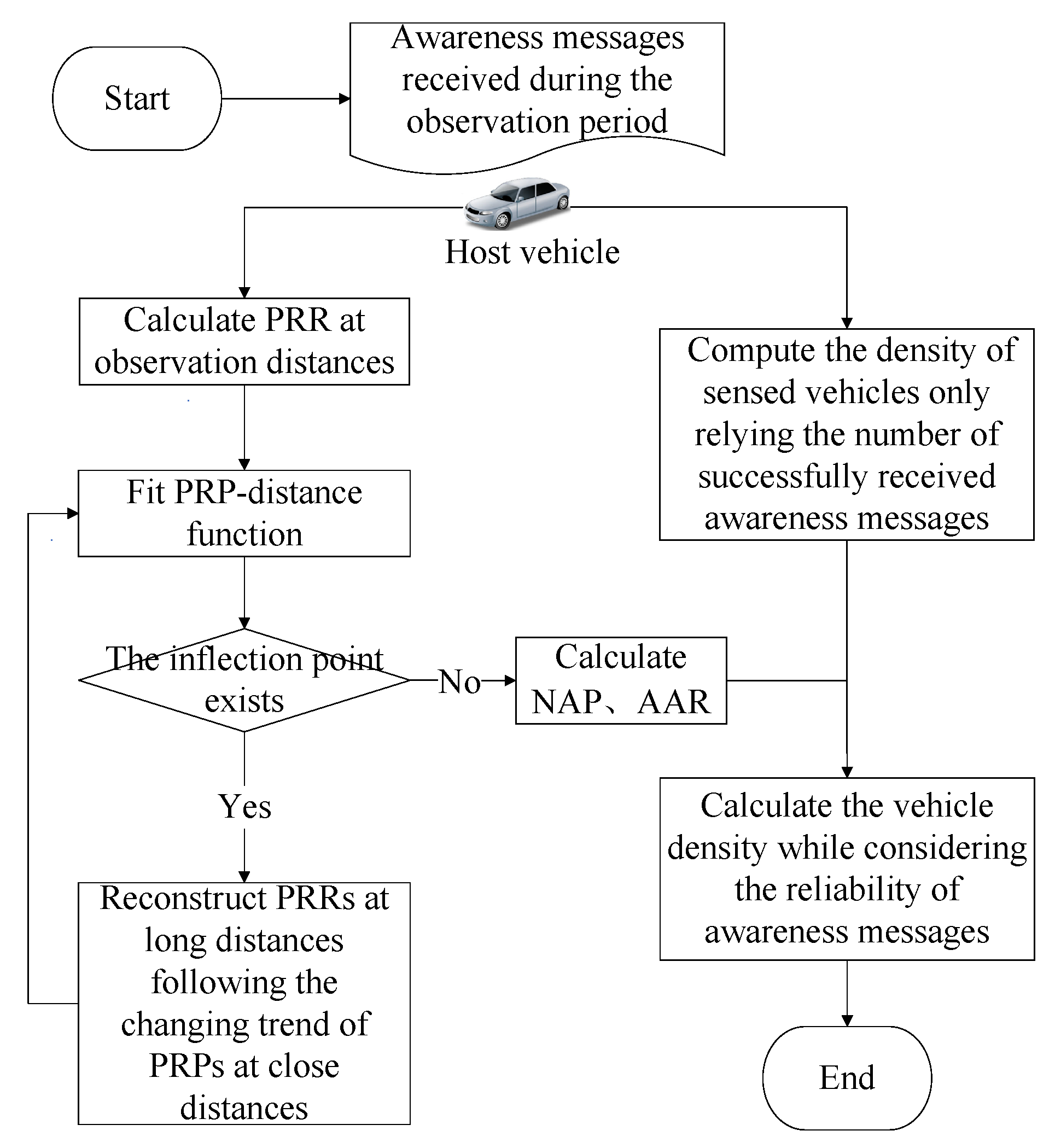


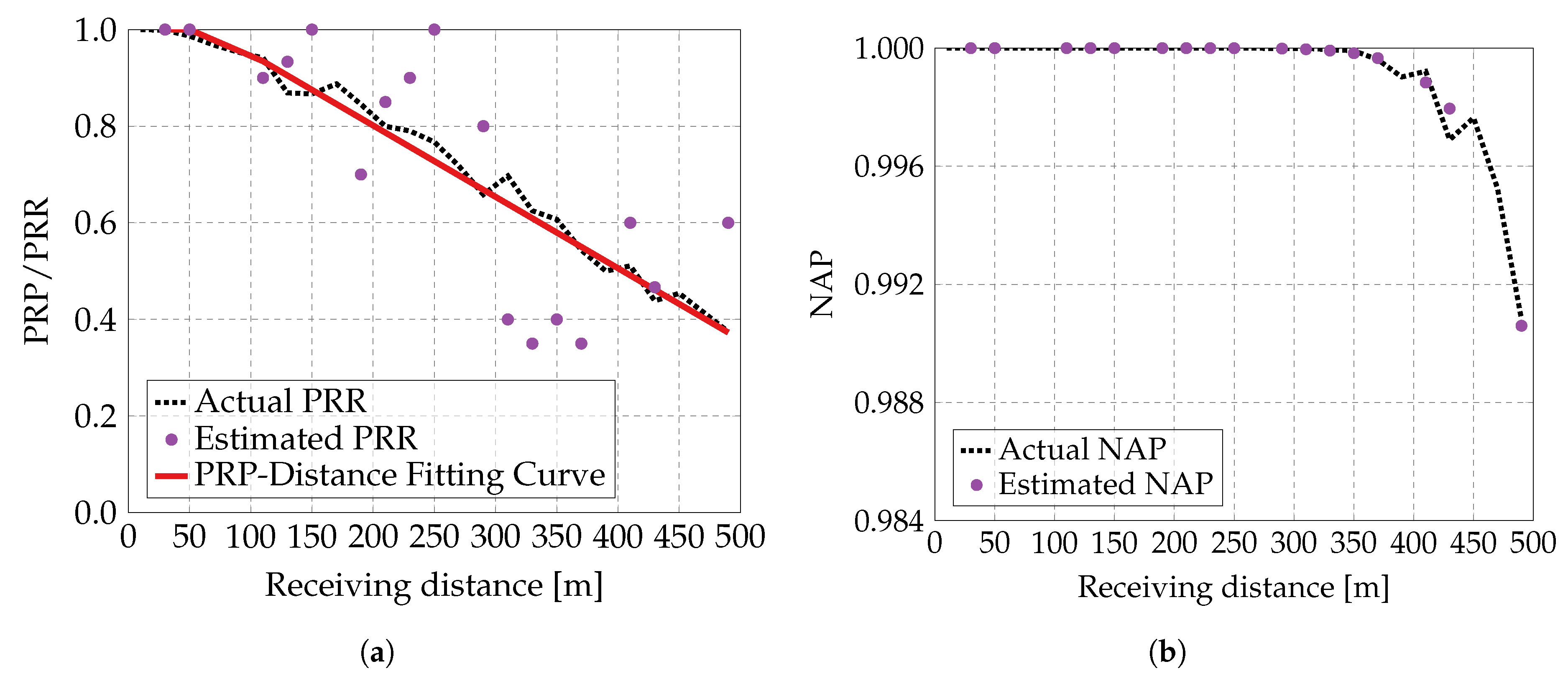
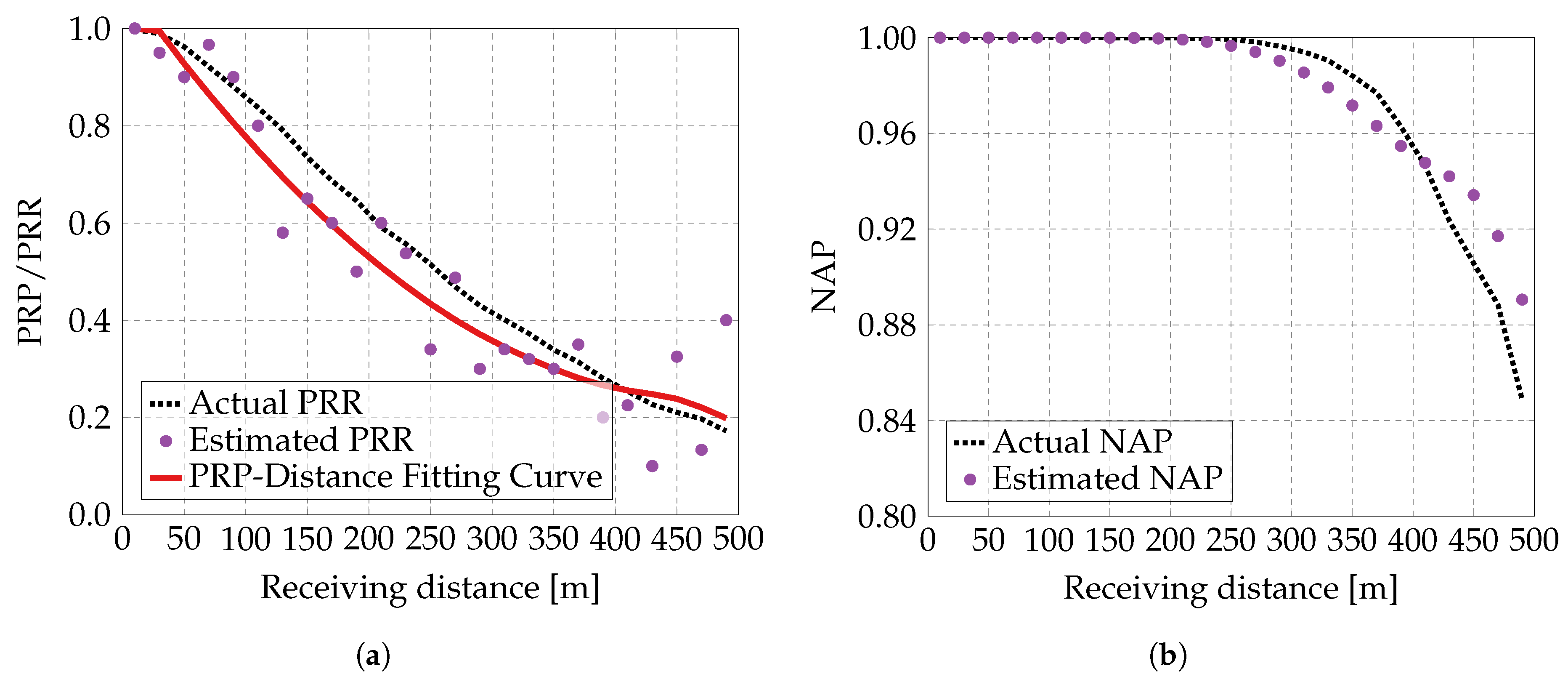
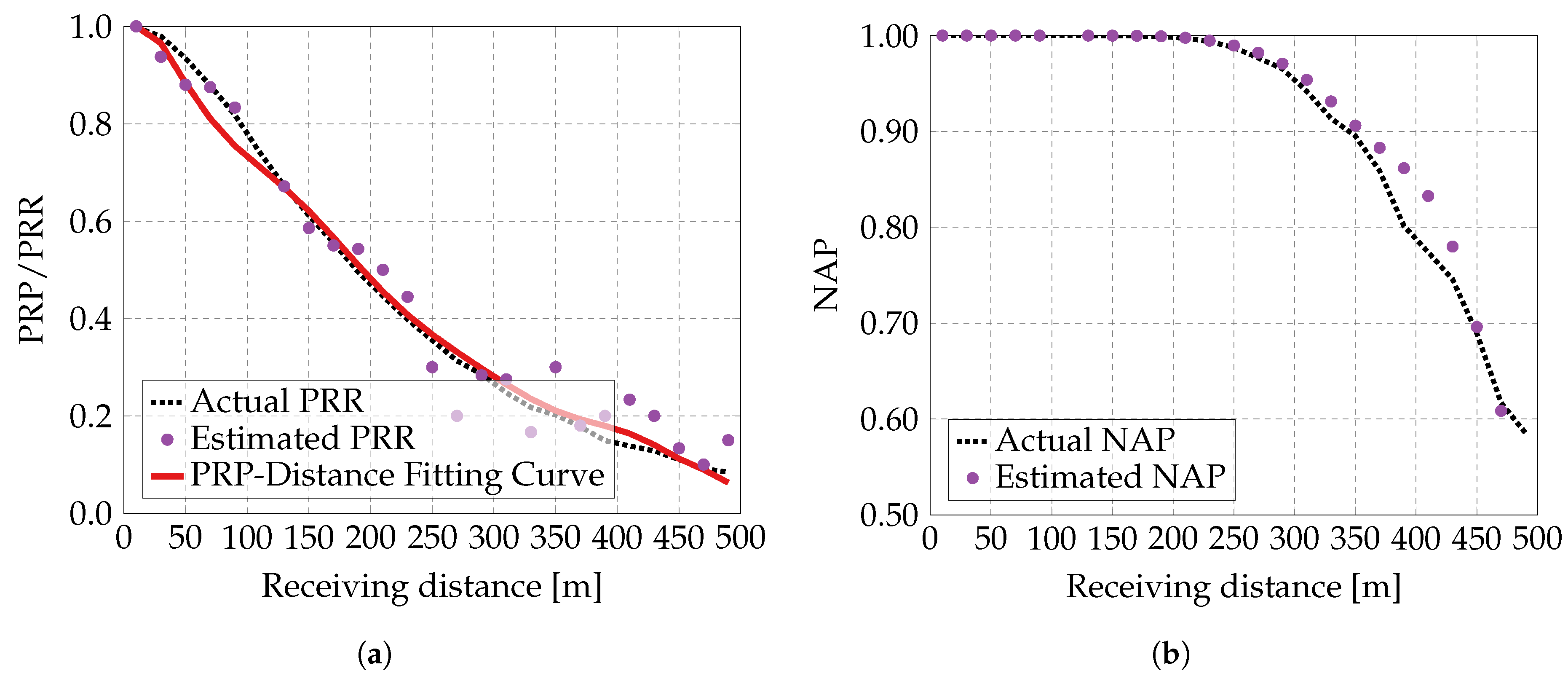
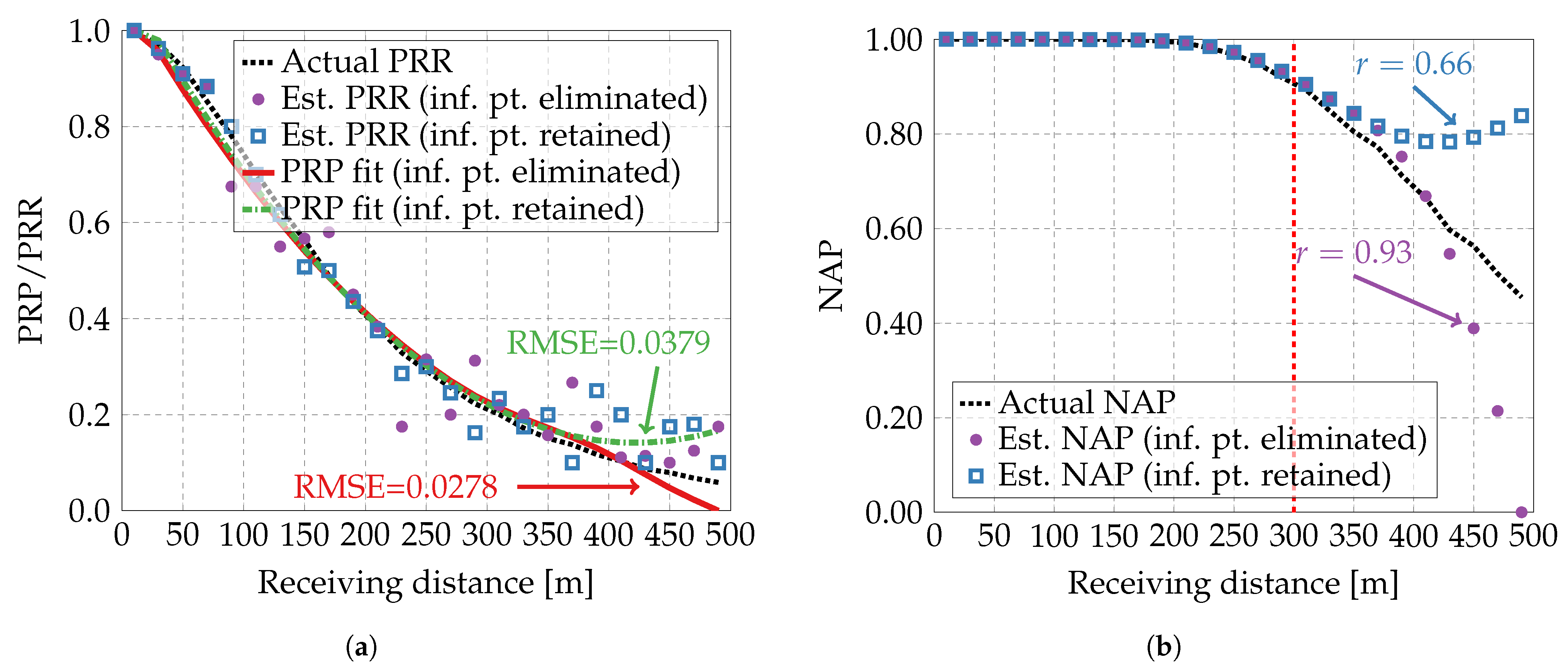
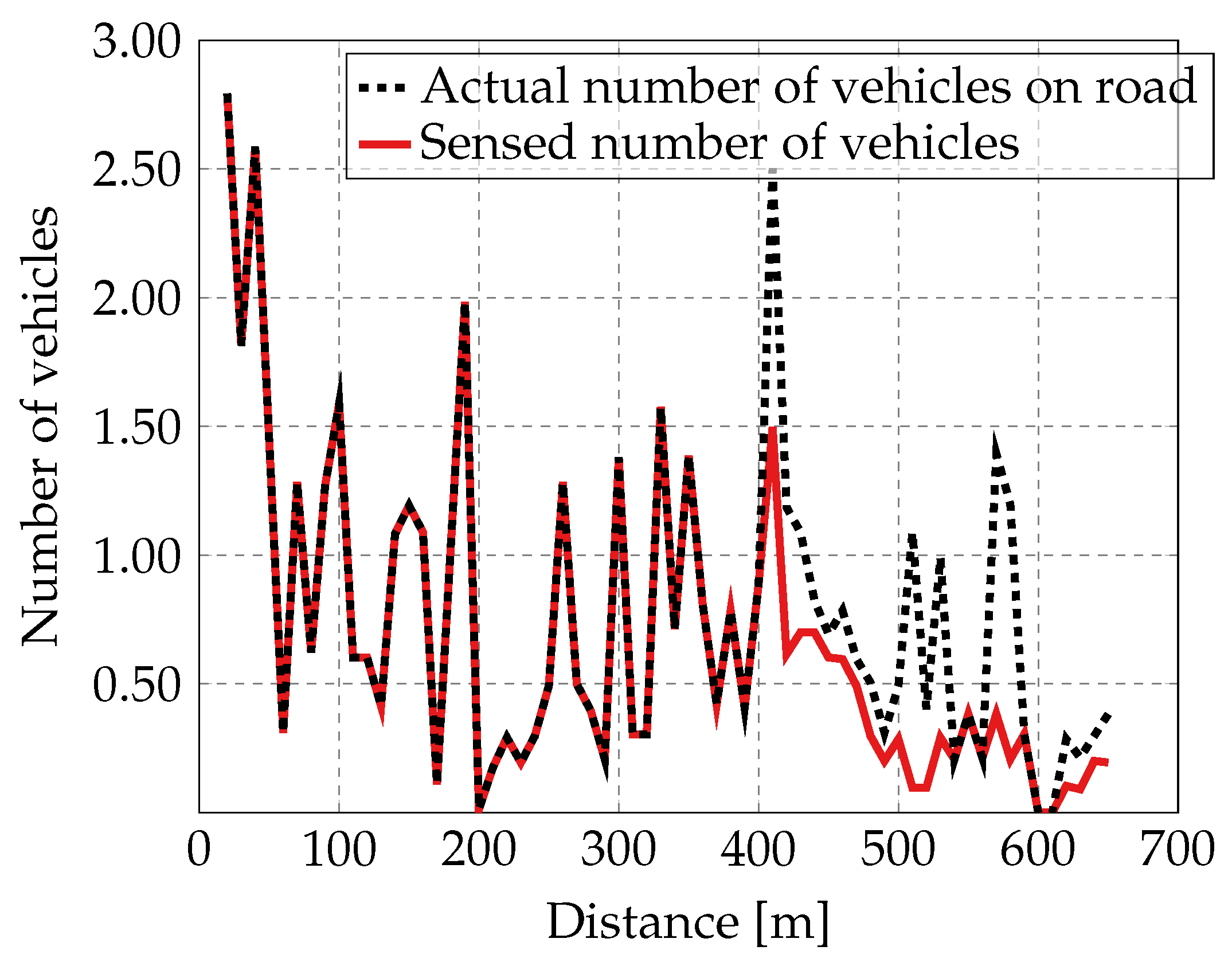

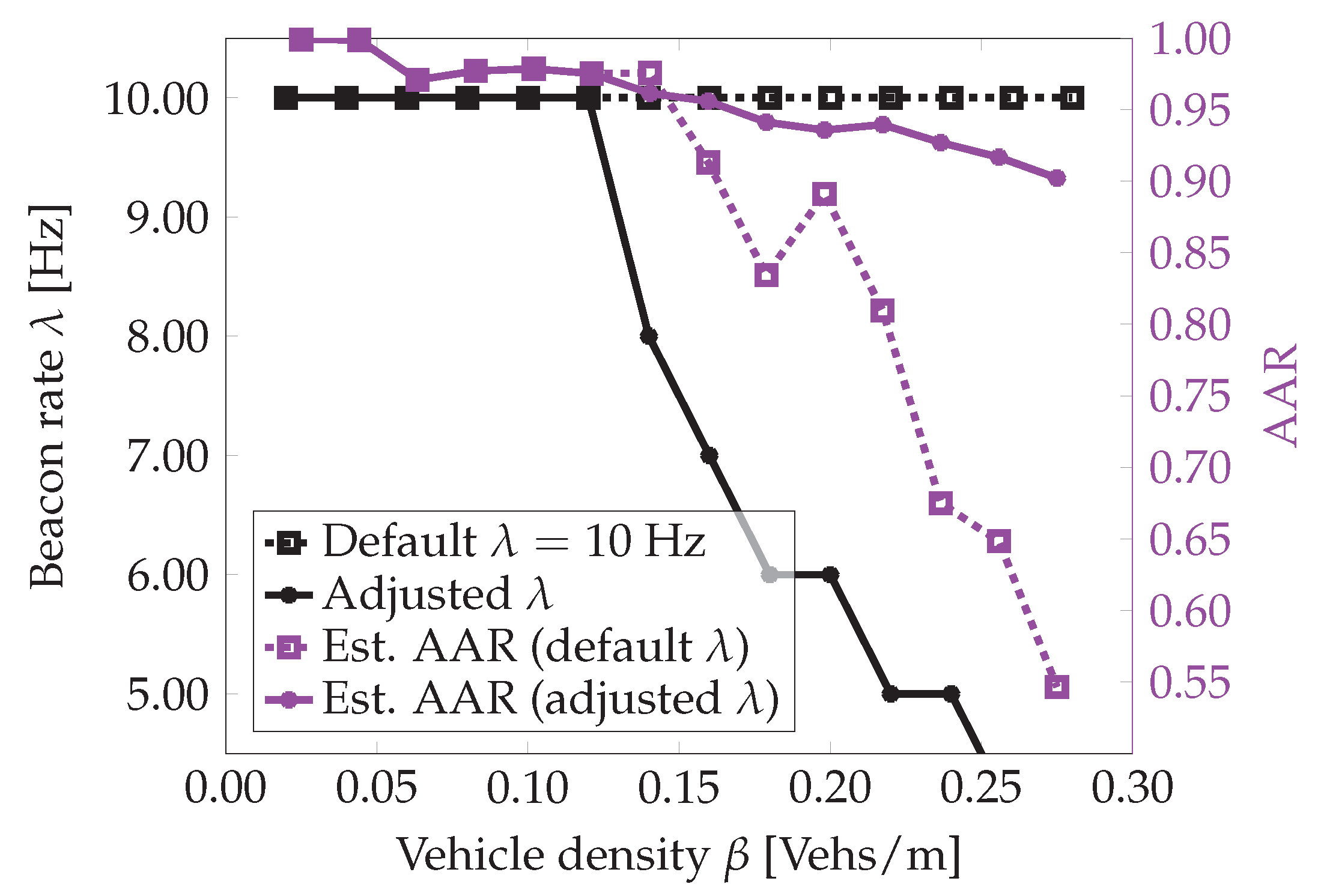
| Parameters | Values | Parameters | Values |
|---|---|---|---|
| Carrier frequency f | 5.9 GHz | Channel bandwidth | 10 MHz |
| Carrier sensing threshold | dBm | Reference distance | 1 m |
| Noise floor power | dBm | Constant | |
| Transmitter gain | 1.0 | Receiver gain | 1.0 |
| MCS | BPSK, | CW W-1 | 15 |
| Path loss exponent | 2 | AIFS | 58 µs |
| Packet length PL | 200 bytes | Slot time | 13 µs |
| PHY preamble + header | 40 µs | MAC header | 272 bits |
| PLCP header | 4 µs | Packet generation interval | 0.1 s |
| Actual vehicle density [vehs/m] | 0.16 | 0.18 | 0.20 | 0.22 | 0.24 | 0.26 | 0.28 |
| Vehicle speed [m/s] | 21.7 | 19.6 | 17.6 | 15.5 | 13.5 | 11.4 | 9.4 |
| Accuracy of AM-based density estimation, Equation (14) | 0.84 | 0.87 | 0.77 | 0.72 | 0.68 | 0.63 | 0.58 |
| Accuracy of AM-AAR-based density estimation, Equation (15) | 0.92 | 0.95 | 0.89 | 0.89 | 0.99 | 0.97 | 0.95 |
Disclaimer/Publisher’s Note: The statements, opinions and data contained in all publications are solely those of the individual author(s) and contributor(s) and not of MDPI and/or the editor(s). MDPI and/or the editor(s) disclaim responsibility for any injury to people or property resulting from any ideas, methods, instructions or products referred to in the content. |
© 2025 by the authors. Licensee MDPI, Basel, Switzerland. This article is an open access article distributed under the terms and conditions of the Creative Commons Attribution (CC BY) license (https://creativecommons.org/licenses/by/4.0/).
Share and Cite
Li, Z.; Wu, X.; Wu, Z.; Zhao, J.; Ma, X.; Bazzi, A. Local Vehicle Density Estimation on Highways Using Awareness Messages and Broadcast Reliability of Vehicular Communications. Vehicles 2025, 7, 117. https://doi.org/10.3390/vehicles7040117
Li Z, Wu X, Wu Z, Zhao J, Ma X, Bazzi A. Local Vehicle Density Estimation on Highways Using Awareness Messages and Broadcast Reliability of Vehicular Communications. Vehicles. 2025; 7(4):117. https://doi.org/10.3390/vehicles7040117
Chicago/Turabian StyleLi, Zhijuan, Xintong Wu, Zhuofei Wu, Jing Zhao, Xiaomin Ma, and Alessandro Bazzi. 2025. "Local Vehicle Density Estimation on Highways Using Awareness Messages and Broadcast Reliability of Vehicular Communications" Vehicles 7, no. 4: 117. https://doi.org/10.3390/vehicles7040117
APA StyleLi, Z., Wu, X., Wu, Z., Zhao, J., Ma, X., & Bazzi, A. (2025). Local Vehicle Density Estimation on Highways Using Awareness Messages and Broadcast Reliability of Vehicular Communications. Vehicles, 7(4), 117. https://doi.org/10.3390/vehicles7040117









